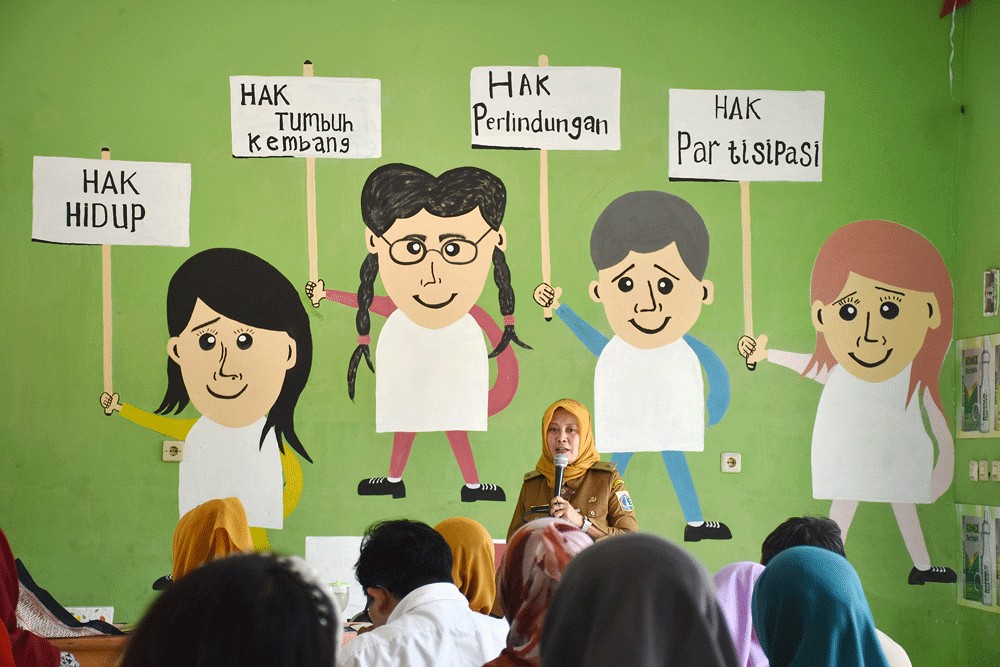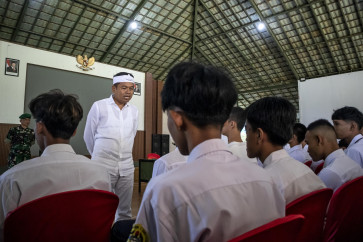Popular Reads
Top Results
Can't find what you're looking for?
View all search resultsPopular Reads
Top Results
Can't find what you're looking for?
View all search resultsSchooling and sex education can help reduce high child marriage rates
Child marriage is a key cause of teenage pregnancy, with its concomitant higher risks of pregnancy and birth complications, including giving birth to premature or underweight babies.
Change text size
Gift Premium Articles
to Anyone

W
hen we commemorate the International Day of Families on May 15, we should remember that despite the decline in child marriage rate globally, our country's progress in tackling the issue remains slow. Many children still trade their optimum period to grow and thrive for the responsibilities of parenthood.
UNICEF ranks Indonesia eighth-highest globally and second in Southeast Asia in terms of the number of child marriages. The latest National Socioeconomic Survey (Susenas) found that 11.21 percent of girls age 20-24 wed before 18, which equals 1.2 million child brides. Within the same population, over 60,000 girls marry before 15. On the other hand, one in every 100 boys marries before 18.
Child marriage determinants include lack of education, poverty, gender inequality and cultural and religious norms. A study held in Bone, South Sulawesi, one of the provinces with the highest rate of child marriage in Indonesia, discovered that teenagers who drop out of school are more likely to marry younger.
Impoverishment, and limited exposure to accurate and reliable knowledge about the harmful impacts of child marriage, are some reasons that parents arrange marriages for their young children to reduce the family's economic burden. Another major factor is parents' desire to prevent shame due to extramarital sex and unwanted pregnancy.
Children who marry before 18 have a four-time lower chance of continuing their studies after high school, further increasing their isolation from peers. The foremost root cause of school dropouts is marriage, followed by doing household chores. Stigma, forced exclusion from school, working and not having enough financial means to complete their study also cause them to stop schooling.
Furthermore, child marriage carries catastrophic physical and mental health consequences. Child marriage is a key cause of teenage pregnancy, with its concomitant higher risks of pregnancy and birth complications, including giving birth to premature or underweight babies. Compared to their adult counterparts, young brides are more likely to deal with sleep deprivation, low self-esteem and depression.
Living as a child bride is also burdensome economically. Work interruption because of childbirth and domestic chores, being less educated and less skilled hinders children from securing decent-paying jobs. Their hard-earned money often needs to be allocated to their children, their parents or their relatives, further perpetuating the poverty cycle.
It is estimated that child brides on average receive 9 percent less of their adulthood income and cost economies at least 1.7 percent of the GDP.
Responding to the above adversities, the government has set a specific target to reduce child marriage. In 2019, the government approved increasing the minimum age of girl marriage from 16 to 19 years old. In the National Mid-term Development Plan (RPJMN) 2020-2024, our country aims to reduce the child marriage rate from 11.2 percent in 2018 to 8.74 percent by 2024 and 6.95 percent by 2030. This plan aligns with the government's effort to contribute to Sustainable Development Goals (SDGs).
Keeping children in school and improving access to quality education are among the best antidotes to child marriage. For every additional year of secondary school, the chance of children marrying before 18 is reduced by 5 percentage points or more. The Global Education Monitoring Report stated that twelve years of education for every girl could reduce global child marriage by 64 percent.
Being educated allows children to be empowered to decide and speak for themselves. They are more exposed to new insights and inspired by more people, which lets them have more options they can pursue. Education also helps take children away from poverty and violence and gives them more confidence and economic opportunities as they are more knowledgeable and skilled. Those who study in secondary school have future incomes two times higher than those without education.
Learning in school also offers more opportunities for the children to become informed about the consequences of marrying and being pregnant at a young age. They will know about their reproductive health, which is vital for their whole well-being.
The long-standing patriarchy of valuing education more for sons than daughters often limits girls from acknowledging their fundamental rights. Learning about children's rights and laws against child marriage is one of the ways to protect girls.
The National Strategy of Child Marriage Prevention designed by the National Development Planning Agency (Bappenas) places sufficient access to comprehensive reproductive health information as one of the key interventions. It specifically mentions the prevention of relationship violence, pornography and the impacts of child marriage. The 2013 Curriculum for senior high school students includes reproductive system and family planning program materials.
However, in practice, reproductive health education has not lived up to the plan. Sex education is still considered taboo in Indonesia; it is inconvenient to bring up sex in daily conversations, especially between children and adults.
Many adults are still hesitant to discuss the topic with youth, as they worry that it will encourage premarital sex. In practice, schools in Indonesia focus only on the human reproductive system and sexually transmitted infections.
Comprehensive sex education should cover sexuality, gender-sensitive issues, consent and sexual-related help and support, as listed in the World Health Organization's International Technical Guidance on Sexuality Education. The emphasis should also be on child marriage prevention as stated in the recently passed law on sexual violence crimes. Outside school, sex education should be delivered by parents and caregivers to ensure sync and continuity.
In the Indonesian context, involving cultural and religious influential figures is crucial in spreading awareness and gathering mass attention. Sexual health campaigns need to be cautiously customized according to the local customs, especially for this sensitive issue. Community role models play a pivotal role in bringing the topic to the table of community conversation. They can ignite the campaign against child marriage and for child empowerment.
Indeed, early marriage does more harm than good in the areas of education, economy and children’s health. Keeping children in school and improving sex education may be the ways to disentangle the ongoing, deleterious child marriage issue.
***
The writer is a physician and an MSc candidate in Public Health, London School of Hygiene & Tropical Medicine, the United Kingdom under Indonesia Endowment Fund for Education (LPDP) scholarship.








